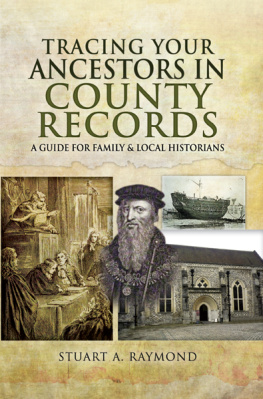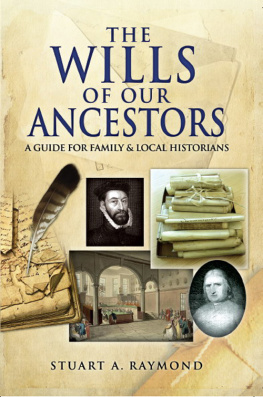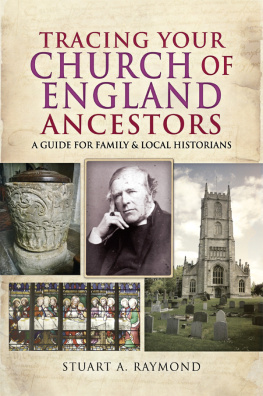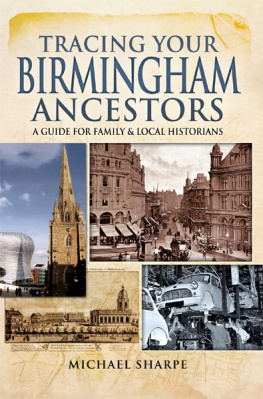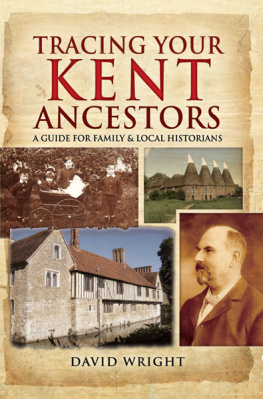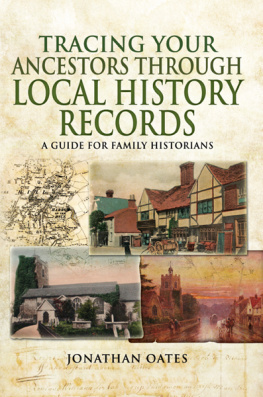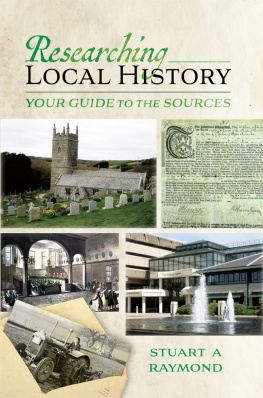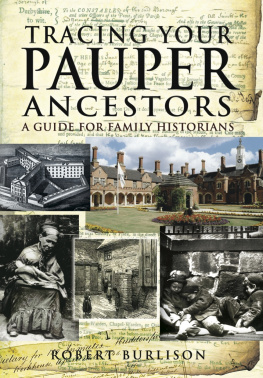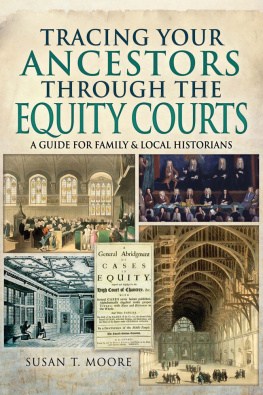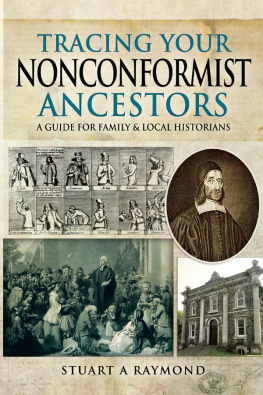FAMILY HISTORY FROM PEN & SWORD
Tracing Secret Service Ancestors
Tracing Your Air Force Ancestors
Tracing Your Ancestors
Tracing Your Ancestors from 1066 to 1837
Tracing Your Ancestors Through Death Records
Tracing Your Ancestors Through Family Photographs
Tracing Your Ancestors Using the Census
Tracing Your Ancestors Childhood
Tracing Your Ancestors Parish Records
Tracing Your Aristocratic Ancestors
Tracing Your Army Ancestors 2nd Edition
Tracing Your Birmingham Ancestors
Tracing Your Black Country Ancestors
Tracing Your British Indian Ancestors
Tracing Your Canal Ancestors
Tracing Your Channel Islands Ancestors
Tracing Your Coalmining Ancestors
Tracing Your Criminal Ancestors
Tracing Your East Anglian Ancestors
Tracing Your East End Ancestors
Tracing Your Edinburgh Ancestors
Tracing Your First World War Ancestors
Tracing Your Great War Ancestors: The Gallipoli Campaign
Tracing Your Great War Ancestors: The Somme
Tracing Your Great War Ancestors: Ypres
Tracing Your Huguenot Ancestors
Tracing Your Jewish Ancestors
Tracing Your Labour Movement Ancestors
Tracing Your Lancashire Ancestors
Tracing Your Leeds Ancestors
Tracing Your Legal Ancestors
Tracing Your Liverpool Ancestors
Tracing Your London Ancestors
Tracing Your Medical Ancestors
Tracing Your Merchant Navy Ancestors
Tracing Your Naval Ancestors
Tracing Your Northern Ancestors
Tracing Your Pauper Ancestors
Tracing Your Police Ancestors
Tracing Your Prisoner of War Ancestors: The First World War
Tracing Your Railway Ancestors
Tracing Your Royal Marine Ancestors
Tracing Your Rural Ancestors
Tracing Your Scottish Ancestors
Tracing Your Second World War Ancestors
Tracing Your Servant Ancestors
Tracing Your Service Women Ancestors
Tracing Your Shipbuilding Ancestors
Tracing Your Tank Ancestors
Tracing Your Textile Ancestors
Tracing Your Trade and Craftsmen Ancestors
Tracing Your Welsh Ancestors
Tracing Your West Country Ancestors
Tracing Your Yorkshire Ancestors
First published in Great Britain in 2016
PEN & SWORD FAMILY HISTORY
an imprint of
Pen & Sword Books Ltd
47 Church Street,
Barnsley
South Yorkshire,
S70 2AS
Copyright Stuart Raymond, 2016
ISBN: 978 1 47383 363 0
PDF ISBN: 978 1 47387 910 2
EPUB ISBN: 978 1 47387 909 6
PRC ISBN: 978 1 47387 908 9
The right of Stuart Raymond to be identified as Author of the Work has been asserted by him in accordance with the Copyright, Designs and Patents Act 1988.
A CIP catalogue record for this book is
available from the British Library.
All rights reserved. No part of this book may be reproduced or transmitted in any form or by any means, electronic or mechanical including photocopying, recording or by any information storage and retrieval system, without permission from the Publisher in writing.
Typeset in Palatino and Optima by CHIC GRAPHICS
Printed and bound in England by
CPI Group (UK), Croydon, CR0 4YY
Pen & Sword Books Ltd incorporates the imprints of Pen & Sword Archaeology, Atlas, Aviation, Battleground, Discovery, Family History, History, Maritime, Military, Naval, Politics, Railways, Select, Social History, Transport, True Crime, Claymore Press, Frontline Books, Leo Cooper, Praetorian Press, Remember When, Seaforth Publishing and Wharncliffe.
For a complete list of Pen & Sword titles please contact
PEN & SWORD BOOKS LTD
47 Church Street, Barnsley, South Yorkshire, S70 2AS, England
E-mail:
Website: www.pen-and-sword.co.uk
CONTENTS

A box of Quarter Sessions documents. What might they tell you? (Wiltshire & Swindon History Centre)
INTRODUCTION
The lives of the plain English folk depicted in the records of Quarter Sessions and Assizes, are the fountain from which the crowd of Shakespeares characters is derived. Every one of his squires, constables, serving men, labourers, clowns, drunkards, and other picturesque villains have their real prototypes in the pages of these records. If history is about people, then anyone aspiring to study the history of ordinary English people needs to consult the Quarter Sessions order books, sessions rolls and other archives preserved in county record offices.
Many people who use these offices do not realise that their original purpose was to preserve the records of Quarter Sessions. Nor do they appreciate the extent of those records, the diverse information that can be found in them and the possibilities for research that they present. The aim of this book is primarily to provide a detailed handbook to English and Welsh Quarter Sessions records, to describe the background to the various different record series and to suggest how they might be used. The duties of Lord Lieutenants, Sheriffs, Assize judges and other county officers were intimately linked with Quarter Sessions, and their records will also be discussed (see ).
England was divided into shires, as the Anglo-Saxons called them, at an early date. The Normans called them counties. For administrative purposes, they were divided up into Hundreds (Wapentakes in the North, Rapes in Sussex, Lathes in Kent), which had their own officers. Hundreds consisted of a number of parishes, which also had their own officers. These were the areas over which Quarter Sessions and related authorities exercised their jurisdictions. In Wales, the shires were not created until 1536.
English Quarter Sessions began in the fourteenth century. Their archives do not generally survive before the sixteenth century, although some fourteenth-century records are in The National Archives. Most of the information in this book relates to the period between the sixteenth and the nineteenth centuries. The administrative functions of Quarter Sessions ended in 1888, when County Councils were created. The records of County Councils and other post-1888 local government institutions will not be dealt with here. Nor will the post-1888 judicial functions of Quarter Sessions, which continued to be exercised for almost another century. The Justice of the Peace, of course, continues to adjudicate today.
Justices of the Peace were also intimately linked with parish officers. The records of parish government have already been described in my Tracing Your Ancestors Parish Records: A Guide for Family and Local Historians (Pen & Sword, 2015), which should be read alongside the present volume.
This book also deals with the records of some other pre-1888 institutions of local government, such as turnpike trusts and commissioners for sewers. However, separate books would be needed to review the records of boroughs, and of Poor Law Unions. Many boroughs had their own Quarter Sessions and Justices of the Peace. Their activities were partially governed by borough charters, and will not be dealt with here. Nor will the various liberties such as Havering at Bower (Essex), the Isle of Ely (Cambridgeshire) and the Hundred of Launditch (Norfolk) which were exempt from the jurisdiction of county Quarter Sessions. The activities of Justices and other county officers in collecting national taxation will not be discussed in detail.
Next page
